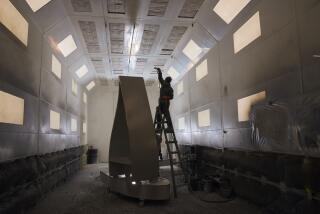Alternate-Energy Search Powers Business Boom
- Share via
The effort by utilities to find new methods of generating electricity--coupled with the public’s increasing environmental awareness--is causing a boom for local alternative energy producers and manufacturers of equipment that use wind, sun or water to produce electricity.
Manufacturers such as San Diego-based Kyocera America, which makes solar panels, and SeaWest, a local company that develops wind turbine projects, are counting on a grass-roots energy awareness movement to boost sales.
Past energy crises have spurred utilities to rely less on fossil fuels and to seek new ways of generating electricity, alternative energy advocates say. They add that, as consumers become more energy-conscious, they’ll become receptive to alternative energy products, such as solar-powered recreational vehicles and homes.
Utilities are already buying electricity from independent power producers, who use wind, solar or hydro power to generate electricity.
“Social responsibility is a major factor these days,” said Karen Bernt, marketing coordinator for SeaWest, which employs 36 workers in a 3,000-square-foot leased facility in Mission Valley. “There’s a lot of pressure on utilities to produce electricity in a cleaner way.”
Founded in 1981, the closely held wind turbine company produces 260 megawatts of electricity annually--enough to power 60,000 homes--for Southern California Edison and Pacific Gas & Electric. Bernt declined to release SeaWest’s revenue figures and earnings, but said the company is profitable.
Ron Higgins, a power contract administrator at SDG&E;, said the local utility is exploring ways to use renewable energy--sun, wind or water--but added that extensive use of such resources is often limited by what nature provides.
“Hydroelectric turbines would be terrific, but we just don’t happen to be blessed with running water resources that we could tap,” Higgins said. “A windmill doesn’t work for us either, because we don’t have areas here that produce consistent wind.
“I think there’s a lot of interest already (to produce electricity with renewable resources), but in some cases, like solar technology, it isn’t cost-effective--yet,” Higgins said.
But cost reductions from technological advances and increasing pressure to reduce pollution should make solar equipment, for example, attractive to utilities in the near future, Higgins said.
“Utilities are being required to put on pollution control equipment,” Higgins said. “With those additional costs, combined with the cost of solar dropping in the future, utilities are going to be moving in their direction.”
According to Al Panton, Kyocera’s solar sales manager, utilities won’t be the only ones turning to photovoltaic (PV) modules--panels that convert sunlight to electricity.
The cost of producing solar panels has already dropped to the point that it is cost-efficient for houses in remote areas to use solar technology rather than conventional generators, Panton said.
“Typically, someone on a utility grid can buy a kilowatt hour of electricity for 8 to 10 cents,” Panton said. “But it will cost you between 25 cents and up to $1 per kilowatt hour if you’re using a standard gasoline generator. With a PV module, it’ll cost you 50 cents per kilowatt hour.
“Besides the cost savings, you don’t have to worry about fueling and maintenance, either,” Panton said. “Solar panels are maintenance-free. There’s no moving parts.”
Such convenience and reduced costs have already helped increase Kyocera’s solar panel sales. In 1989, Kyocera posted revenues of $10 million, doubling 1988 revenue. Panton said the company expects to hit $20 million in revenues this year.
Kyocera America is the San Diego-based subsidiary of Kyocera Corp. of Kyoto, a $3-billion multinational company specializing in high-technology ceramics.
Kyocera America, founded in 1969 in Silicon Valley and moved to San Diego two years later, also manufactures ceramic packages that house computer chips used for computers and electronic equipment. Kyocera America employs 1,200 employees at its 300,000-square-foot facility in Kearny Mesa.
Kyocera’s photovoltaic modules are made of silicon cells coated with special chemicals that, when struck by sunlight, activate electrons that move along the wires, generating electricity. Kyocera’s standard model is a 51-watt panel, 18 inches by 39 inches, that produces 220 watt hours a day.
Although the cost of the panel has dropped to $350 from a $650 in 1983, Panton concedes that it is still not economical for the typical resident to convert his house to solar power.
According to an SDG&E; study, a typical home in San Diego uses 450 kilowatt hours per month, Panton said. “That would require 60 panels . . . at an installed cost of $30,000.
“That’s why we’re currently focusing on people who live off the utility grid,” Panton said. “But it’s already applicable for boats and RVs.”
By the year 2000, however, Panton said solar panels will be producing electricity at a rate equivalent to utilities.
“At that point, we’re hoping developers will begin putting PV modules in their new homes,” Panton said.
More to Read
Inside the business of entertainment
The Wide Shot brings you news, analysis and insights on everything from streaming wars to production — and what it all means for the future.
You may occasionally receive promotional content from the Los Angeles Times.










